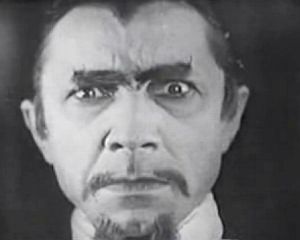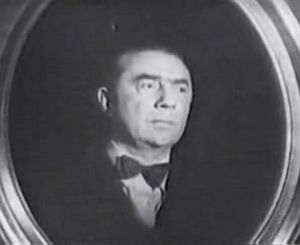No edit summary |
mNo edit summary |
||
| Line 8: | Line 8: | ||
Lugosi was offered the part of the monster in the 1931 ''Frankenstein'', Universal's follow-up to ''Dracula'', but declined, since the part involved heavy make-up and no dialogue; the part went to Boris Karloff instead, launching a horror career that would eclipse Lugosi's. He instead freelanced in a variety of horror films, in a range of non-vampiric roles: the evil voodoo master in ''White Zombie'' (1931), the goat-like Sayer of the Law in ''The Island of Lost Souls'' (1932), and teamed with rival Karloff as a desperate, tragic doctor who skins his evil nemesis alive in ''The Black Cat'' (1934), interspersed between various mysteries (the 1931 Charlie Chan vehicle ''The Black Camel''), adventure serials (playing first villain and then hero in three ''Chandu'' serials), and a rare comedic turn as a pompous general in [[W. C. Fields|W.C. Fields']] ''International House'' (1933). |
Lugosi was offered the part of the monster in the 1931 ''Frankenstein'', Universal's follow-up to ''Dracula'', but declined, since the part involved heavy make-up and no dialogue; the part went to Boris Karloff instead, launching a horror career that would eclipse Lugosi's. He instead freelanced in a variety of horror films, in a range of non-vampiric roles: the evil voodoo master in ''White Zombie'' (1931), the goat-like Sayer of the Law in ''The Island of Lost Souls'' (1932), and teamed with rival Karloff as a desperate, tragic doctor who skins his evil nemesis alive in ''The Black Cat'' (1934), interspersed between various mysteries (the 1931 Charlie Chan vehicle ''The Black Camel''), adventure serials (playing first villain and then hero in three ''Chandu'' serials), and a rare comedic turn as a pompous general in [[W. C. Fields|W.C. Fields']] ''International House'' (1933). |
||
| − | Lugosi starred in 1935's ''Mark of the Vampire'', though his Count Mora is revealed to be an actor hired to ferret out the real culprit, and he gradually was reduced to working for "poverty row" studios PRC (as a mad pharmacist in 1939's ''The Devil Bat'') and Monogram, appearing in nine movies from 1940 through 1944 (including two outings opposite the East Side Kids). Universal offered him occasional respites in their continuing monster franchise, with a key cameo as the tortured lycanthropic gypsy Bela in ''[[The |
+ | Lugosi starred in 1935's ''Mark of the Vampire'', though his Count Mora is revealed to be an actor hired to ferret out the real culprit, and he gradually was reduced to working for "poverty row" studios PRC (as a mad pharmacist in 1939's ''The Devil Bat'') and Monogram, appearing in nine movies from 1940 through 1944 (including two outings opposite the East Side Kids). Universal offered him occasional respites in their continuing monster franchise, with a key cameo as the tortured lycanthropic gypsy Bela in ''[[The Wolf Man]]'' (1941) and originating the role of the hunchbacked Ygor in ''Son of Frankenstein'' (1939) and ''Ghost of Frankenstein'' (1941), before finally playing the monster himself in ''Frankenstein Meets the Wolfman'' (1943). Following more low-budget B movie fodder, Lugosi finally returned to his most famous creation, reprising Count Dracula in the monster rally comedy ''Abbott and Costello Meet Frankenstein'' (1948). It was to be his last movie for a major studio, as increasingly poorer work opposite no-name actors followed, in such spoofs as ''Bela Lugosi Meets a Brooklyn Gorilla'' and ''Mother Riley Meets the Vampire'', finally culminating in work for the legendarily bad director Ed Wood. Lugosi died after filming scant footage for Wood's infamous ''Plan Nine from Outer Space'' (replaced by a stand-in wearing a cape over his face). He was buried in his Dracula cape. |
==References== |
==References== |
||
Revision as of 05:04, 29 October 2009

Bela Lugosi terrifies the Muppet Babies, in footage from White Zombie

Lugosi gazes out at Baby Fozzie and Piggy in scenes from Ghosts on the Loose
Bela Lugosi (1882-1956) was a Hungarian actor who become a cinematic icon through his portrayal of Dracula in the 1931 Universal film, and thereafter was largely typecast in horror movies.
Lugosi began his career on stage, touring in his native land (even performing in Transylvania, appropriately enough). Following a successful, lengthy stint with Budapest's National Theater, he moved to the United States in the 1900s, performing in New York, on and off Broadway, in the early 1920s. In 1927, he was selected to play the lead in the Broadway play Dracula, with a West Coast tour following until 1929. As Dracula, Lugosi used his own slick-backed hair, coming to a point in the center of the forehead, wore evening dress and a cape, and adopted an aristocratic manner while speaking in his thick native accent. When Lugosi reprised the role on film in 1931, all of these elements became the quintessential image of Dracula, just as Boris Karloff's Frankenstein Monster (with a square-head, bolts, and stitches) and stage actor Arthur Wontner's Sherlock Holmes (with deerstalker cap, Inverness cape, and curved pipe) defined the characters in the public mind. In all three instances, none of these elements were present in the source text.
Lugosi was offered the part of the monster in the 1931 Frankenstein, Universal's follow-up to Dracula, but declined, since the part involved heavy make-up and no dialogue; the part went to Boris Karloff instead, launching a horror career that would eclipse Lugosi's. He instead freelanced in a variety of horror films, in a range of non-vampiric roles: the evil voodoo master in White Zombie (1931), the goat-like Sayer of the Law in The Island of Lost Souls (1932), and teamed with rival Karloff as a desperate, tragic doctor who skins his evil nemesis alive in The Black Cat (1934), interspersed between various mysteries (the 1931 Charlie Chan vehicle The Black Camel), adventure serials (playing first villain and then hero in three Chandu serials), and a rare comedic turn as a pompous general in W.C. Fields' International House (1933).
Lugosi starred in 1935's Mark of the Vampire, though his Count Mora is revealed to be an actor hired to ferret out the real culprit, and he gradually was reduced to working for "poverty row" studios PRC (as a mad pharmacist in 1939's The Devil Bat) and Monogram, appearing in nine movies from 1940 through 1944 (including two outings opposite the East Side Kids). Universal offered him occasional respites in their continuing monster franchise, with a key cameo as the tortured lycanthropic gypsy Bela in The Wolf Man (1941) and originating the role of the hunchbacked Ygor in Son of Frankenstein (1939) and Ghost of Frankenstein (1941), before finally playing the monster himself in Frankenstein Meets the Wolfman (1943). Following more low-budget B movie fodder, Lugosi finally returned to his most famous creation, reprising Count Dracula in the monster rally comedy Abbott and Costello Meet Frankenstein (1948). It was to be his last movie for a major studio, as increasingly poorer work opposite no-name actors followed, in such spoofs as Bela Lugosi Meets a Brooklyn Gorilla and Mother Riley Meets the Vampire, finally culminating in work for the legendarily bad director Ed Wood. Lugosi died after filming scant footage for Wood's infamous Plan Nine from Outer Space (replaced by a stand-in wearing a cape over his face). He was buried in his Dracula cape.
References
- Count von Count on Sesame Street is a parody of Bela Lugosi as Dracula, from his hairstyle and attire to his accent. In the early sketches, Jerry Nelson's voice more closely resembled Lugosi, later gaining more comedic elements from the popular perception of the Lugosi Dracula. The early, more sinister Count often entered with a cape over his face, as Lugosi did in Dracula and Abbott and Costello Meet Frankenstein, and his hand movements are Lugosi-esque. The character's hypnotic powers draw from both Dracula and the 1932 film White Zombie, in which Lugosi played a voodoo doctor who hypnotizes his victims through his eyes.
- Stock footage of Lugosi was used in multiple episodes of Muppet Babies, with dialogue dubbed by Frank Welker (imitating the Dracula voice). The fifth season episode "Is There a Muppet in the House?" incorporated extensive footage from White Zombie and Ghosts on the Loose (1943). In the babies' fantasy, Lugosi becomes the sinister "Mr. Mean Eyes." In the seventh season episode "Remote Control Cornballs," early scenes with Baby Gonzo featured more White Zombie footage, as well as Lugosi as Dracula himself, turning into an animated bat in Abbott and Costello Meet Frankenstein (mistakenly identified in the end credits as Abbott and Costello Meet the Mummy).
